#acrolithe
Explore tagged Tumblr posts
Text
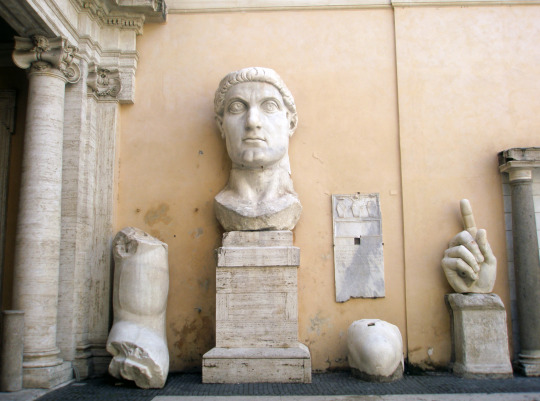
Colossus of Constantine as an example for acroliths. Around 300 A.D.
Learn more https://www.archaeologs.com/w/acrolith/
#archaeology#archaeological#archaeologs#history#dictionary#art#sculpture#greek sculpture#acrolith#colossus#constantine#greek art#ancient greece#roman empire#arkeoloji#tarih#sanat#heykel
96 notes
·
View notes
Text
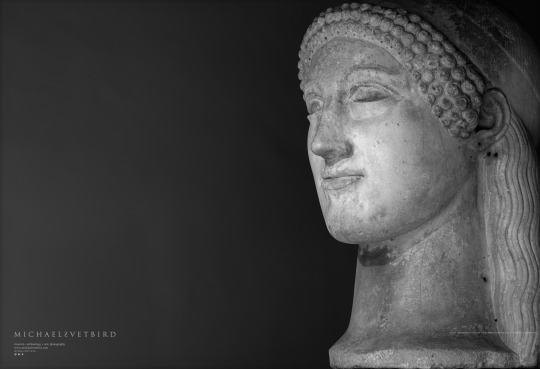

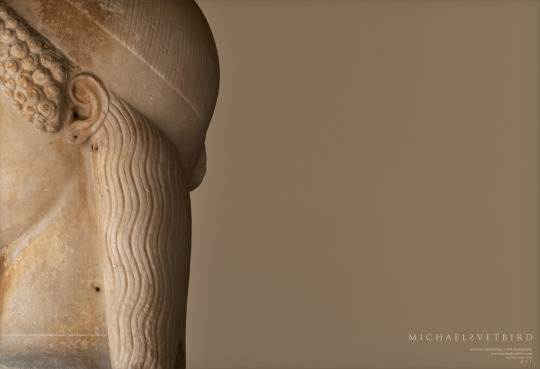
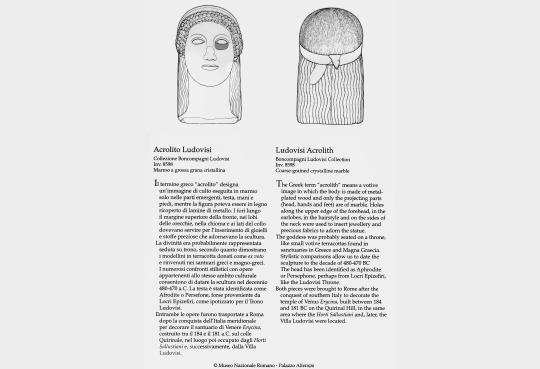
ACROLITH | Head of a Goddess, Aphrodite or Persephone: 'Ludovisi Acrolith' [said] From Locri Epizefiri, Magna Grecia, dated ca 480-470 BC. Brought to Rome 1 BC [pls refer to ©MNR Palazzo Altemps desc. pic 4].
Sun 18 June 2023, Rome: Palazzo Altemps, Museo Nazionale Romano | MNR PA [Ground Floor] • Web : https://museonazionaleromano.beniculturali.it/en/palazzo-altemps • FB : https://www.facebook.com/MNRomano • IG : @museonazionaleromano • TW : @MNR_museo
MNR PA | Michael Svetbird phs©msp | 18|06|23 6000X4100 600 [I., II.] The photographed object is the collection item of MNR PA and subject to copyrights. [non commercial use | sorry for the watermarks]
📸 Part of the "HEADS.Sculpture" MSP Online Photo-gallery: 👉 D-ART: https://www.deviantart.com/svetbird1234/gallery/78520831/heads-sculpture
👉 FB Album: https://www.facebook.com/media/set?set=a.1400262423675664&type=3
.
#rome#palazzo altemps#museo nazionale romano#altemps#acrolith#magnagrecia#greekmythology#goddess#archaic#votive#sculpture#head#heads#aphrodite#persephone#antiquity#archaeology#archeologia#ancient#arthistory#museology#mythology#ancient sculpture#ancientart#photogallery#photography#archaeologyphotography#sculpture photography#museumphotography#michaelsvetbird
30 notes
·
View notes
Text

Io Saturnalia!
Saturnalia is an ancient Roman religious festival honoring Saturn, who was pardoned after his expulsion from Olympus by Jupiter and subsequently regarded as a benevolent god of agricultural abundance.
The first documented Saturnalia was held in 497 BCE for the dedication of the Temple of Saturn in Rome. An annual festival commemorating the dies natalis (anniversary) of this event was held thereafter on December 17. The celebration proved so popular that it was extended to three days, then to an entire week - from December 17 to 23. There was a 24 hour break to take care of home and business - and then everyone went back to celebrating with the dies natalis (anniversary) of the dedication of the temple of Sol Invictus on December 25!
The religious observation of Saturnalia occurred on the first day of the festival. The monumental cult statue of Saturn was acrolithic, a composite of carved ivory over a wooden scaffold, saturated with olive oil to help prevent the ivory from cracking, and “garments” of gilded wood and/or fabric - air currents stirring the fabric would have created the illusion of the statue moving. The legs of the statue, which were bound with woolen bands for most of the year - again, it is speculated, to help prevent the ivory from cracking, though perhaps there was also a religious meaning - were unbound for the duration of the Saturnalia. After a religious procession to the Temple of Saturn and the proper rituals were performed, a lectisternium was held, a ceremony in which a smaller statue of the god was placed upon a dining couch and offered food and drink as part of a banquet attended by Roman elites. The general Saturnalia festival followed these solemnities.
The Saturnalia recalled the mythical Age of Saturn, when crops grew without human toil and humanity lived in harmony with nature and each other. Elements of the festival included days off from work, gatherings of family and friends, wearing brightly-colored garments, preparing and indulging in copious amounts of food and drink, playing games, attending theatrical and musical performances, giving gifts, decorating homes and businesses with garlands and wreaths of evergreens gleaming with sparkly ornaments, light from candles, lamps, torches, and bonfires - all of which probably sound at least a little familiar!
The reversal of normal societal roles was emblematic of Saturnalia: the emperor bestowed largess upon soldiers and the general populace, employers gave bonuses to workers, families with the means to do so gave food and clothing the poor, those with employed/enslaved workers played at being workers themselves by serving meals to the staff, and children were allowed to participate in "adult" activities such as attending theatrical performances and gambling with dice.
You'll find ideas for celebrating Saturnalia here and here.
If you’re able to do so this year, I hope you will continue the Saturnalia tradition of gifts and role-reversals by supporting your local food bank, shelter, or the charity of your choice by volunteering or making a donation.
I'm going to put in a good word for Soles4Souls (a nonprofit rated 4/4 stars by Charity Navigator) with locations in the US, UK, Canada, Asia, and Europe. They provides shoes and clothing to people in crisis. From now until Dec 31, a donation of $20 will provide two pairs of new, brand-name athletic shoes for children experiencing homelessness.
⊱⋅⋆✵⋆⋅*✧*⋆⋅༻*⋆⋅⋅⋅🏛⋅⋅⋅⋆*༺⋅⋆*✧*⋅⋆✵⋆⋅⊰
Featured Image Description:
A fresco depicting an ornate, multi-colored temple with finials and columns standing atop a podium decorated with brightly painted foliage and flowers. Just in front of the temple stands a painted statue of Saturn - or perhaps it is the actual deity Saturn. Saturn's tunic and mantle appear to swirl slightly with movement. He gazes upwards at his left shoulder, atop of which a bird, perhaps an eagle, has just landed and he brandishes a scythe, emblematic of his agricultural function, in his right hand.
This is a renaissance-era fresco from the garden house of the Villa Medici, Rome. Photo by Warburg.
Image source: https://commons.wikimedia.org/wiki/File:Roma_(20).jpg
Image license: https://creativecommons.org/licenses/by-sa/3.0/deed.en
Remix: I cropped the image and removed some of the image adjacent to the temple and podium.
155 notes
·
View notes
Text
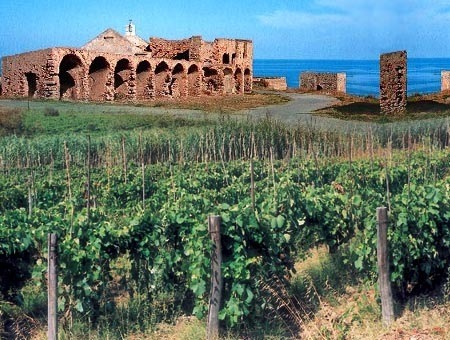
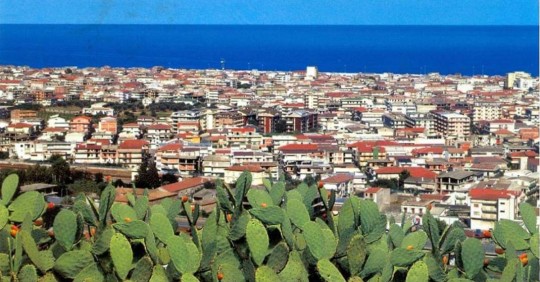
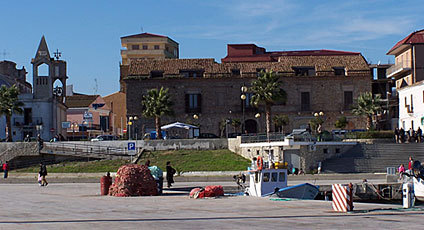

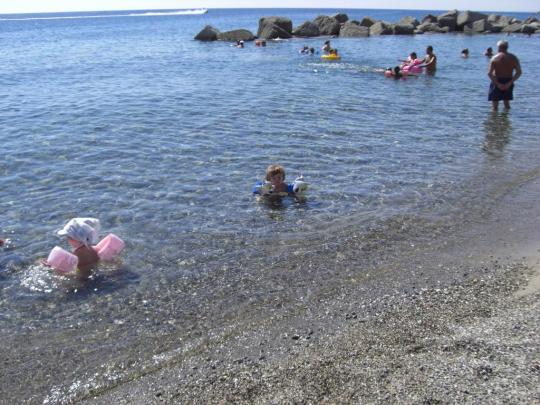
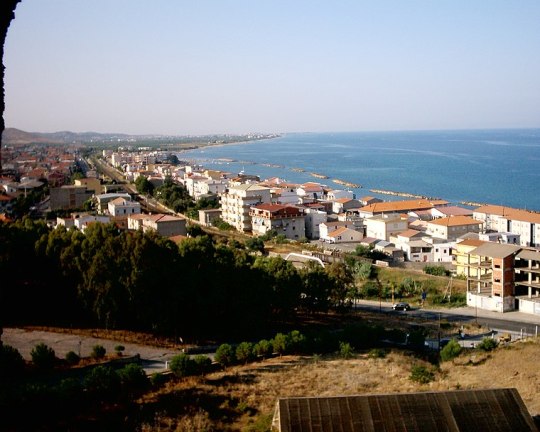
Cirò Marina, Calabria, Italy
Cirò Marina is a seaside town on the Ionian coast of Calabria. This is the wine-producing area of the region, with a tradition in wine-making that stretches back over a thousand years.
Cirò Marina is an old land, inhabited in the distant past by Greek settlers who probably arrived there between the 7th and 6th centuries BC and founded the town of Krimisa.
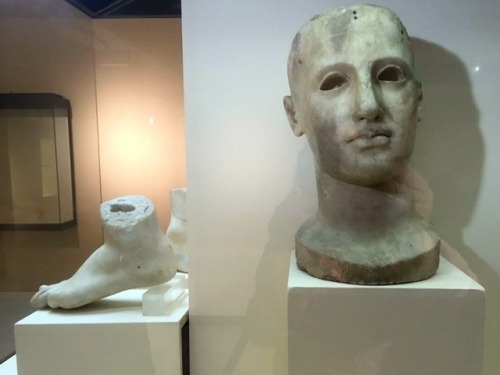
This Greek colony was also known because of the Temple of Apollo Aleus on the promontory of Punta Alice. The best-known finding which emerged from the archaeological excavations consists of some parts of the acrolith of Apollo Aleo, namely the head, both feet and part of the hand, today exhibited at the National Archaeological Museum of Reggio Calabria.
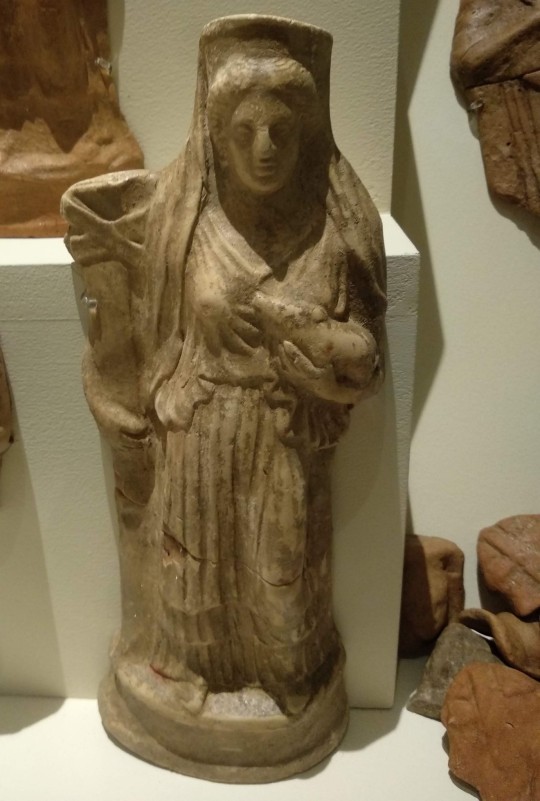
Other important discoveries which are now preserved at the Civic Museum of Cirò Marina, are a simulacrum of Demeter and a clay figurine representing Demeter as well. The first one is a bust in terracotta, dating back to the 3rd century BC. In the second one, the goddess is depicted with a torch and a little pig. The torch symbolizes Demeter's search for her daughter Kore/Persephone, kidnapped by the God of the Underworld and down there, in the dark, searched by her desperate mother. The fire of the torch burns and purifies. Combined with the little pig, it speaks of pig sacrifices that were held on numerous ritual occasions dedicated to the goddess, as often demonstrated by the discovery of butchered bones in sanctuaries in pits, interpreted as remains of ritual meals and sacrifices to the goddess.
In Ancient Greece the sacrifice of pigs to ensure the fertility of the land was a widespread practice. During the Thesmophoria festivals (ancient Greek: Θεσμοφόρια), purely female festivals dedicated to Demeter, the slaughtered pigs were thrown into pits, then the recovered remains were scattered on the fields.
Follow us on Instagram, @calabria_mediterranea
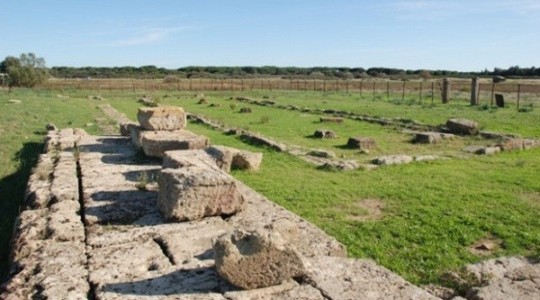
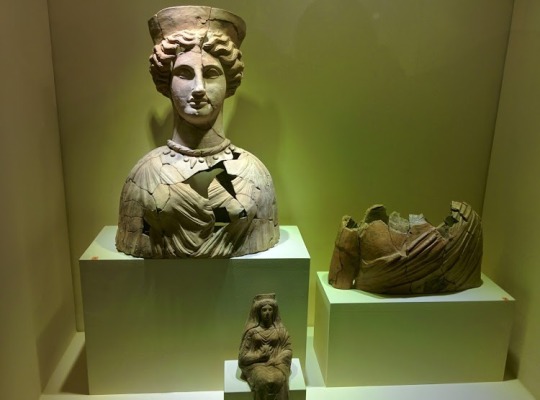
#cirò marina#cirò#calabria#south italy#italy#italia#southern italy#mediterranean#mediterranean sea#sea#seascape#seaside#seashore#beach#vineyards#vineyard#grapes#italian#europe#landscape#italian landscape#landscapes#beaches#italian landscapes#greek art#greek#ancient greece#art#history#archaeology
78 notes
·
View notes
Text
Dungeon Dialogue: The Alzadaal's Legacy
The Bhaflau Remnants #1 (X: 8.4, Y: 12.7) - Arriving at the isle
Estinien: Time to learn just how authentic our map truly is... ↳ G’raha Tia: Our adventure begins! Urianger: Behold. The lanterns ignite in the glyph's presence. Y’shtola: And thus we take our first step into the unknown. G’raha Tia: This isle is where we find the vault's entrance?
The Bhaflau Remnants #2 (X: 11.6, Y: 12.3) - 1st Hidden Bridge
Y’shtola: The glyph works its magic once more... ↳ G’raha Tia: An invisibility spell removed, mayhap? Urianger: What a peculiar enchantment... G’raha Tia: A bridge out of thin air...or cleverly hidden!
First Boss, Before engaging (X: 14.0, Y: 9.7) - Ambujam
Y’shtola: My, what dense aether this creature has. ➝ Urianger: 'Tis a rare breed of jellyfish─one with a sting, I imagine. Estinien: This gelatinous eyesore bars our path.
First Boss, After defeating (X: 14.0, Y: 9.7) - Ambujam
Estinien: If only it had been a squid. Imagine all the dried rations... ↳ Y’shtola: I'd rather not. Oh look, is that a teleporter? Urianger: Might that device be our sought-after “entrance”? Y’shtola: Shall we move on? That looks to be a teleporter. The teleporter bears you deep beneath the waves...
The Arrapago Remnants #1 (X: 11.2, Y: 14.6) - Undersea Vault
Looming Voice: Glyph of passage detected. Confirming bearer's identity... G’raha Tia: Look! We're deep under the Bounty! ↳ Estinien: Then our map was no fake after all. Urianger: This must be the satrap's vault. Such fascinating design... Y’shtola: We've descended quite some distance... Estinien: The ocean floor... The map was no fake after all.
The Arrapago Remnants #1 (X: 12.1, Y: 13.6) - Alzadaal’s Rampart #1
Alzadaal’s Rampart #1: Unrecognized aetherial signature... Brazen thief! You will proceed no further! Alzadaal’s Rampart #1: Locating denizens. Opening portal...
The Arrapago Remnants #2 (X: 11.2, Y: 11.1) - Alzadaal’s Rampart #2
Alzadaal’s Rampart #2: Locating denizens. Opening portal... Urianger: I must needs memorize these defenses... ↳ Y’shtola: You are really quite serious about this consulting role of yours. Estinien: We appear to have angered the vault guardians. G’raha Tia: Judging by these defenses, we must be nearing the treasure!
Second Boss, Before engaging (X: 11.2, Y: 8.9) - Armored Chariot
Urianger: Hm. The key guardians appear mechanical in nature. ↳ G’raha Tia: Please remember to heal whilst you take notes! Y’shtola: It will take more than this to halt our expedition. G’raha Tia: A formidable-looking foe. Be on your guard!
Second Boss, During the Fight (X: 11.2, Y: 8.9) - Armored Chariot
Armored Chariot: Turn back, treasure seeker, or this vault will be your tomb.
Second Boss, After defeating (X: 11.2, Y: 8.9) - Armored Chariot
Armored Chariot: Your greed will prove your undoing... Urianger: Attack routines, behavioral patterns... There is much to report. ↳ G’raha Tia: I only hope the Loporrits do not “misinterpret” the data. Y’shtola: Shall we continue onwards? G’raha Tia: Another obstacle overcome! Now on to the next!
The Zhayolm Remnants #1 (X: 9.6, Y: 12.3) - The Vault’s Inner Chambers #1
Estinien: Aye...this should more than cover the price of the map. ↳ Y’shtola: How much did you pay for it, anyway? Urianger: Mountains of gold to dazzle the eye. Noted. Y’shtola: I assume we've reached the vault's inner chambers, then?
The Zhayolm Remnants #2 (X: 10.4, Y: 10.8) - The Vault’s Inner Chambers #2
Alzadaal’s Acrolith #1: Secure the treasure. Alzadaal’s Acrolith #1: Slay the looters. Urianger: Secret doors, hidden paths. More elements to consider. ↳ G’raha Tia: Ere long, you shall be a veritable vault expert! Estinien: What other riches might this one vault hold? G’raha Tia: There are yet more rooms beyond!? Alzadaal’s Acrolith #2: Repel the intruders. Alzadaal’s Acrolith #2: Flee, or be feed for the fish.
Third Boss, Before engaging (X: 13.1, Y: 10.3) - Kapikulu
Y’shtola: 'Tis wrapped in aether-imbued silks... ↳ Urianger: No mere adornments, then. Urianger: 'Tis some manner of arcane automaton... Estinien: What is this oversized mammet?
Third Boss, During the Fight (X: 13.1, Y: 10.3) - Kapikulu
Kapikulu: Warning. This vault is under my protection. Failure to withdraw will invite chastisement.
Third Boss, Special: Spin Out (X: 13.1, Y: 10.3) - 1st time
Kapikulu: Spin and fumble! Stumble and fall! Kapikulu: Leave now, and live. This is your final warning. Urianger: Those silks... Fashioned by alchemy, I suspect. Y’shtola: How undignified... Estinien: What foolishness is this...? G’raha Tia: We regroup...and counterattack! Alphinaud: My head... Is everyone all right? Alisaie: You'll...ulp...pay for that! Thancred: Well...that was an experience.
Third Boss, Special: Spin Out (X: 13.1, Y: 10.3) - 2nd time
Kapikulu: Willful trespass confirmed. You have chosen...death. Kapikulu: All intruders will be slain! Urianger: The enchanted fabric saps our very strength. Y’shtola: Oh, you burn now, weaver. Estinien: Why can I not jump free? Too much rich food of late... G’raha Tia: Just let...me catch...my breath! Alphinaud: Keep your wits, and it's not so bad... Alisaie: Again!? Grrr, this is getting old! Thancred: Ulp... I think I might be sick...
Third Boss, After defeating (X: 13.1, Y: 10.3) - Kapikulu
Urianger: Hmmm, a fitting sentinel... Y’shtola: What is this place? Estinien: We've found all the treasure, then? G’raha Tia: A hidden room within a hidden vault...
Alzadaal's Legacy Dungeon Dialogue Infographic
24 notes
·
View notes
Text
The Sanctuary of Apollo Alois in Cirò, Calabria, Italy
Regarding the town of Cirò Marina, on the Eastern Coast of Calabria, the first thing that comes to mind is the DOC wine that is produced in that area. It was the Ancient Greeks who, due to the fertility of the land, called the whole of Calabria "Enotria", which means land where vines are grown. Some types of vines still present in Calabria are of Greek origin, such as Gaglioppo and Greco Bianco. But Cirò Marina is also remembered for the ancient Hellenic colony which was named Krimisa. In this city there was a temple dedicated to the god Apollo Aleo. According to legend, Philoctetes, a famous archer from Thessaly, returning from Troy after the victory of the Greeks against the Trojans, arrived in southern Italy. Here he wandered for a long time and right in the area of today's Cirò Marina he founded the city of Krimisa, consecrating a temple to the god Apollo, called Aleo. This name derives from the Greek word “alàomai” and means to wander, just as Philoctetes wandered in Southern Italy for a long time.
In the 1920s, on the promontory of Punta Alice, some bricks and rough-hewn stones were discovered during the works to drain the ponds, which had made the coast unlivable. Having informed the famous archaeologist Paolo Orsi of this, the excavations for the discovery of the temple began on 18 April 1924. The temple was built in two stages. In the late archaic period, late 6th century BC, the building had a narrow and elongated plan, the cell open at the front and wooden peristasis. At the beginning of the 3rd century BC. a peripteral Doric building (8 x 19 columns) was built. According to the archaeologist Orsi, the temple was destroyed during the Second Punic War. During the excavations, the marble head of the acrolith and its feet were found. The acrolith was a statue formed by the head, hands or arms and feet in stone, marble or ivory, while the body was formed by a support structure of poor quality material, covered with fabric, where the sculpted parts were attached. The holes on the head and feet were used to house the bronze wig and sandals.
During the excavations led by Orsi, numerous votive offerings were found, including a small gold foil statue depicting Apollo with bow and patera. According to tradition, Philoctetes dedicated his famous bow mentioned in the Iliad to Apollo. The finds discovered are located in the National Museum of Reggio Calabria, in the State Museum of Crotone and in the Museum of Cirò Marina.
Follow us on Instagram, @calabria_mediterranea
Il Santuario Apollo Alois di Cirò
Quando si parla di Cirò Marina (Kr), la prima cosa che viene in mente è il vino DOC che si produce in quella zona. Furono i greci che, per la fertilità della terra, chiamarono tutta la Calabria “Enotria”, cioè terra dove si coltiva la vite. Alcuni tipi di vitigni ancora presenti in Calabria, sono di origine greca, come il gaglioppo e il greco bianco. Ma Cirò Marina è anche ricordata per l’antica…
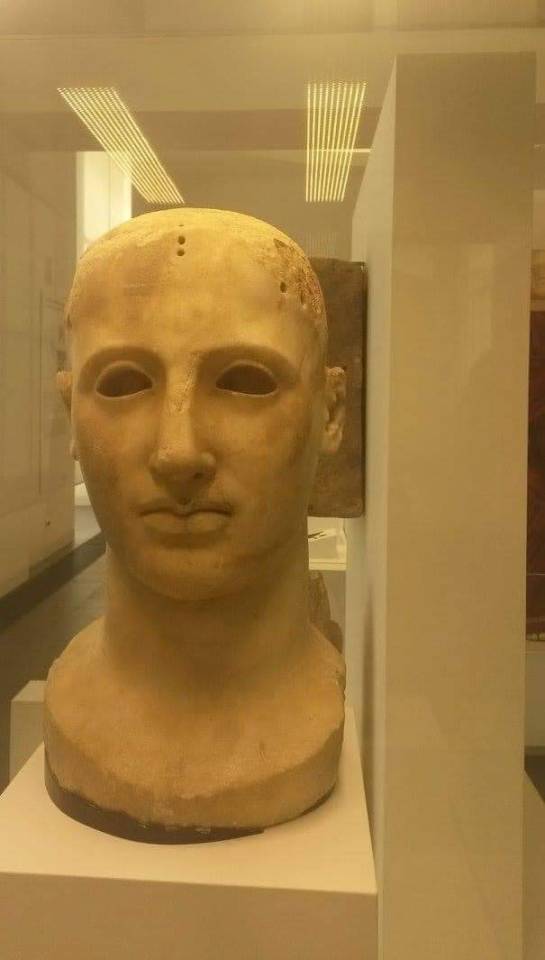
View On WordPress
#cirò#cirò marina#calabria#archaeology#archeology#ancient#art#history#ancient history#ancient art#greek#magna grecia#magna graecia#mediterranean#italy#italia#south italy#southern italy#italian#europe
9 notes
·
View notes
Text
𝐒𝐍𝐎𝐖 - 𝐖𝐇𝐈𝐓𝐄 𝐁𝐋𝐀𝐍𝐊𝐄𝐓 𝐎𝐅 𝐅𝐑𝐎𝐙𝐄𝐍 𝐂𝐑𝐘𝐒𝐓𝐀𝐋𝐒 𝐒𝐇𝐄𝐋𝐓𝐄𝐑𝐄𝐃 𝐀𝐑𝐈𝐃 𝐋𝐀𝐍𝐃𝐒𝐂𝐀𝐏𝐄 𝐁𝐄𝐍𝐄𝐀𝐓𝐇 . but even snowflakes look like ashes in the dark ━━ embers of luster perishing silently . stains of blood , alike morbid constellation upon empty canvas , carved their way into velutinous surface ; rivalry cast aside amidst settling tempest . curses stood no chance , when eye to eye with two enigma’s , yet carried their quirks to harm on rare occasions . ❝ dazai . ❞ absence of sounds occupied the space between them , consumed the naive seconds one by one . sapphire irises , 𝐭𝐡𝐞𝐢𝐫 𝐯𝐢𝐨𝐥𝐞𝐧𝐭 𝐡𝐮𝐞 𝐨𝐟 𝐛𝐥𝐮𝐞 , were robbed of obsidian shades ; everything about him was intense . ❝ osamu . show me . ❞

@acrolithe ♡ ‘ 𝐝 𝐟𝐨𝐫 𝐚𝐧 𝐚𝐟𝐟𝐞𝐜𝐭𝐢𝐨𝐧𝐚𝐭𝐞 𝐰𝐢𝐧𝐭𝐞𝐫𝐲 𝐠𝐞𝐬𝐭𝐮𝐫𝐞
#acrolithe#☽ ——「gσʝσ sαƚσɾυ」 / ❛ when granted everything you can’t do anything.#(( their kind of intimacy is just perfect ))
2 notes
·
View notes
Note
just trying to rule out some scenarios so… ‘statue’ for the ask game ;) xxx
nope! no statue! :)
send me a word and I'll tell you if it's in theogony chapter 8!
#not the same as 'acrolith' tho.....this IS a James chapter ;)#ask#firefeufuego#word game#theogony#thank uuuu sweet Rosie!
5 notes
·
View notes
Text

@acrolithed asked : talk abt tumblr user kozome / acrolithed please ! :pleading: ( send me a url and i’ll gush about them ! always accepting . )


of course !!! i’d love to talk about you, sweetheart !! okay, okay, so first things first, your kenma !! i love your kenma ! i love reading your threads and just getting more time to see him!! i love how you write him - on that note, i really love your writing style !! like the way you convey your muse’s thoughts without out right saying them if that makes sense ! you weave it into your prose which is just so nice !! also, okay, i’ll be completely real with you for a second here: i’ve never read or seen nana, but l iSTEN, it’s been on my to watch/read list. but seeing your blog really makes me want to watch/read it ! i love seeing you characterize these characters and i just itch to know more about them whenever you post !! and you writing also shines on that account too !! oh ! and your COLOR CHOICES !!! ABSOLUTELY !! BEAUTIFUL !!! i love seeing your use of color both for your edits and just overall on both your blogs !! stunning !!!!
3 notes
·
View notes
Photo



secret santa for @acrolithed <3
athena i love u so MUCH. i paniced this entire time bcos i didnt know what to do becaus ei jus. i wanted to give you somethin! cool! and i jsut. fuck dude im so glad we’re friends. i love our late night talks and that we can talk about anything. youre such a wonderful person and a beautiful girl. your soul is a kindness i’ve never seen before. i love you mwah mwah mwah i hope you have a wonderful holiday season and i cant wait for us to both suffer in school again
also i forgot to give this to u i think but ive had it for months so take this, a playlist of dazai coping with odasakus death.
4 notes
·
View notes
Text



HEAD of Female Acrolith: "Marble [head], Copper and calcedony [eyes]" 470-260 BC. Found in Magna Grecia | Unknown provenance [?]
[Loan from] Museo Gregoriano Profano, Musei Vaticani | MV • Web : https://www.museivaticani.va/content/museivaticani/en.html • IG : @vaticanmuseums Exhibited [18|06|23] in Baths of Diocletian, Museo Nazionale Romano "The Instant and Eternity, Between us and the ancients" exhibition • Web : https://museonazionaleromano.beniculturali.it/en/baths-of-diocletian • IG : @museonazionaleromano
MV BOA | Michael Svetbird phs©msp | 18|06|23 6200X4100 600 [I., II.] The photographed object is the collection item of MV and subject to copyrights. [non commercial use | sorry for the watermarks]
📸 Part of the "Small Format Sculpture and Miniature Artefacts" MSP Online Photo-gallery:
👉 D-ART: https://www.deviantart.com/svetbird1234/gallery/69450077/small-format-sculpture-and-miniature-artifacts
👉 FB Album: https://www.facebook.com/media/set/?set=a.859777984390780&type=3
.
#rome#vatican#vaticanmuseums#museogregorianoprofano#bathsofdiocletian#termedidiocleziano#museonazionaleromano#archaeologicalmuseum#magnagrecia#acrolith#female#head#sculpture#votive#ancientsculpture#antiquity#ancient#archaeology#archeologia#heritage#museology#mythology#ancient art#art history#antiquities#photo gallery#archaeologyphotography#sculpturephotography#museumphotography#michaelsvetbird
15 notes
·
View notes
Photo


𝚂𝚃𝚁𝙸𝙺𝙴 𝙲𝙾𝙼𝙼𝙰𝙽𝙳𝙴𝚁 𝙼𝙾𝚁𝚁𝙸𝚂𝙾𝙽: 1 / ?
* do not reblog unless you are a partner.
4 notes
·
View notes
Photo
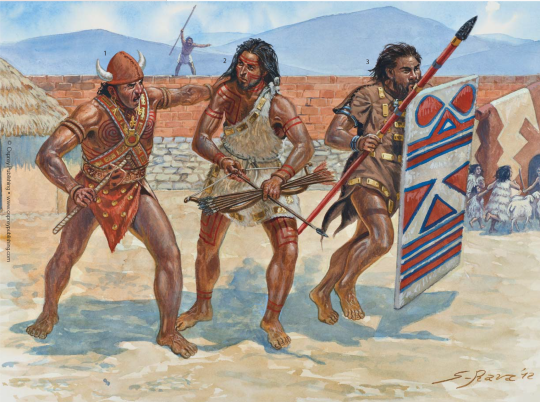
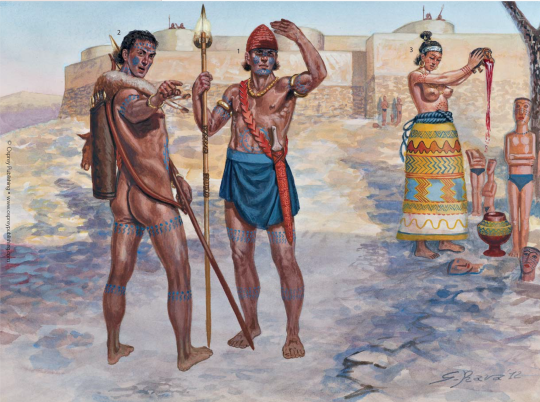

Artwork by Giuseppe Rava from Early Aegean Warrior 5000-1450 BC (Osprey Publishing). Image descriptions from the book below.
EARLY CONTINENTAL AEGEAN SIEGE WARFARE, SESKLO, ABOUT 4400 BC
The scene represents the hypothetical incursion of raiders against the fortified Neolithic settlement of Sesklo. Note the house reconstruction based upon the work of the archaeologist in the Volos Museum.
The ‘Pelasgian’ citadel leader is brandishing a copper axe and wears a splendid example of a copper dagger inserted in leather and copper belt. Jewellery, such as earrings, necklaces and bracelets, was commonly worn as a status symbol by both genders during this period. On the leader’s head is a primitive form of pilos cap, fitted with horns similar to those discovered in a steatite statuette of the period, probably reflecting the worship of the bull and the sacral character of the leader.
The body of this hunter-warrior is covered in tattoos in red minium, similar to those on the acrolithic statuettes of Dimini. Note the obsidian arrowheads and the primitive shape of the bow, reconstructed according to archaeological findings and graffiti. His simple but effective hide clothing was probably very common in Neolithic settlements in the Aegean region.
This man represents one of the elite warriors of the citadel who formed the bodyguard of the leader. His spear and the hypothetical reconstruction of his square shield (some scholars draw comparison with those of Middle East Sumerian culture) indicate the possibility of fighting in a pre-phalanx formation.
CYCLADIC SETTLEMENT AND FORTRESS IN KASTRI-CHALANDRIANI, SYROS, ABOUT 2300 BC
The warrior is copied from a statuette from Syros. He wears a prototype Greek pilos, made from organic material. The spear, from Amorgos, has its point attached to the shaft by means of holes in the blade. Note the dagger from the same locality, worn inside a typical baldric in red leather, decorated in a herringbone pattern.
The design of circular and geometrical tattoos on the body of this hunter can be seen on the remains of a number of statuettes. The early bow, wood reinforced with goat’s horn and sinews, is copied from a specimen represented on a mosaic from Knossos. In Cycladic graves a connection is noticeable between weapons and bone tubes, which often contained blue azurite pigments (in the Manika cemetery these are predominantly associated with female skeletons). The kind of female garment seen here worn by
this priestess, in the colours of the Dama of Phylakopi and in the tradition of coloured Aegean clothes, bears close similarity with Sumerian and Mesopotamian costumes and is also represented on an early Minoan ivory cylinder from Knossos, dated around 2100 BC. Note her rich jewels, taken from specimens from Mochlos and Archanés.
CENTRO-EUROPEAN MIGRATION ON THE PRESENT-DAY GREEK MAINLAND ABOUT 2000-1800 BC
The plate sets out to show a group of those Indo-European peoples who migrated into Greece around 2000–1800 BC, probably from the Balkans and Central Europe.
The warriors in the foreground wear early forms of boar’s tusk helmet copied from the Mariupol and Kolonna specimens. This very primitive boar’s tusk helmet shows that this style of reinforcement and decoration was probably introduced to the Aegean world by the Indo-Europeans migrating from central and north European regions around 2000–1800 BC. Their weapons and jewellery are copied from various finds in central Greece, such as the bronze spearhead from Thiva (Thebes).
The ‘proto-Greek’ Mynian woman is copied from a pottery idol from Euboea. Note the early Aegean style of her garments, borrowed from Crete and the islands.
The early form of chariot is copied from a Late Neolithic pottery model dated 1700 BC from central Europe (Slovakia). The use of the chariot was most likely spread to the Greek mainland from the Near East after the Middle Bronze Age (about 1950–1550 BC) as a result of the central and eastern European migration and the Achaeans’ trade contacts with those regions, although the early attestation of its use in war comes from the Mycenaean Graves A stele.
111 notes
·
View notes
Text
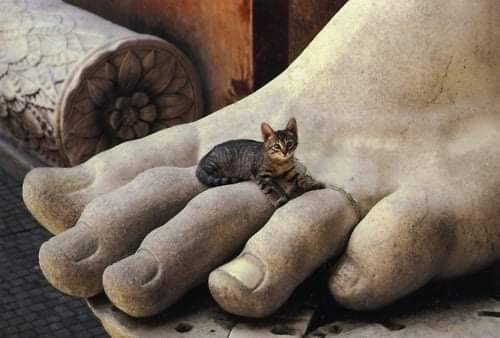
Cat on Constantine’s Foot, Capitoline Museums, Rome, Italy.
The Colossus of Constantine was a huge acrolithic statue of the late Roman emperor Constantine the Great (c. 280–337) that once occupied the west apse of the Basilica of Maxentius on the Via Sacra, near the Forum Romanum in Rome. Portions of the Colossus now reside in the Courtyard of the Palazzo dei Conservatori of the Capitoline Museums, on the Capitoline Hill, above the west end of the Forum.
150 notes
·
View notes
Text
𝐂𝐇𝐀𝐑𝐀𝐂𝐓𝐄𝐑 𝐎𝐔𝐓𝐋𝐈𝐍𝐄.


𝐟𝐥𝐚𝐰𝐬
moody | short-tempered | emotionally unstable | whiny | controlling | conceited | possessive | paranoid | liar | impatient | cowardly | bitter | selfish | power-hungry | greedy | lazy | judgmental | forgetful | impulsive | spiteful | stubborn | sadistic | petty | unlucky | absent-minded | abusive | addict | aggressive | childish | callous | clingy | delusional | cocky | competitive | corrupt | cynical | cruel | depressed | deranged | egotistical | envious | insecure | insensitive | lustful | delinquent | overthinker | guilt complex | reclusive | reckless | nervous | oversensitive | perfectionist | pessimistic | naive
𝐬𝐭𝐫𝐞𝐧𝐠𝐭𝐡𝐬
honest | trustworthy | thoughtful | caring | brave | patient | selfless | ambitious | tolerant | lucky | intelligent | confident | humble | generous | merciful | observant | wise | clever | charming | cheerful | optimistic | decisive | adaptive | calm | protective | proud | diligent | considerate | compassionate | good sportsmanship | friendly | empathetic | passionate | reliable | resourceful | sensible | sincere | witty | funny
𝐬𝐤𝐢𝐥𝐥𝐬 &. 𝐡𝐨𝐛𝐛𝐢𝐞𝐬
art | acting | astronomy | animals | archery | sports | belly dancing | bird watching | blacksmithing | boating | calligraphy | camping | candle making | casino gambling | ceramics | racing | chess | music | cooking | crochet | weaving | exercise | swordplay | fishing | gardening | ghost hunting | ice skating | magic | engineering | building | inventing | leather-working | martial arts | meditation | origami | parkour | people watching | swimming | puppetry | pyrotechnics | quilting | reading | collecting | shopping | socializing | storytelling | writing | traveling | exotic dancing | singing | yoga | gaming | surfing
tagged by : @longerhuman
tagging : @parieha @guiltscorched @sleeplesswork @aevisong @truethes @lureri @acrolithe
6 notes
·
View notes
Photo

acrolithed said:
HIII MORVEN u r so mean 2 me.... u never answer to my discord messages 👺 NCKSN JUST KIDDIN i love u sweetheart thank you for being around to listen and talk even when i’m this🤏🏻close 2 shaving my head from the current Stressor of the Week™️ I NEVER SAID IT BUT how do u capture the voices of all ur muses so well... BYE hand over the talent 🤲🏻 i love your oda & elise to bits & im excited to see you write the best boy dazai !! this isn’t a threat but if u ever leave me i will delete ur knees❤️

i made this icon last time you sent me something cute and must use it every time you do now !
HIII ATHENA.... i love you so much. i’m srry discord is homophobic and hates showing me your msgs </3 ok so many its just athena phobic.... brb suing discord..
AAAAAA i could never leave u you idiot.
you: dont leave me ok me, who’s spent countless nights up talking to u and written u poetry and fawned over u since the day we met: uh............................................. yeah i.... i dont think thats gonna b a problem.
#one day we will meet and on that i day i will FIGHT YUO.#acrolithed#the way ur one of my bffs <3 we dont have 2 talk abt it its ok#& * ask.#& * ooc.
2 notes
·
View notes